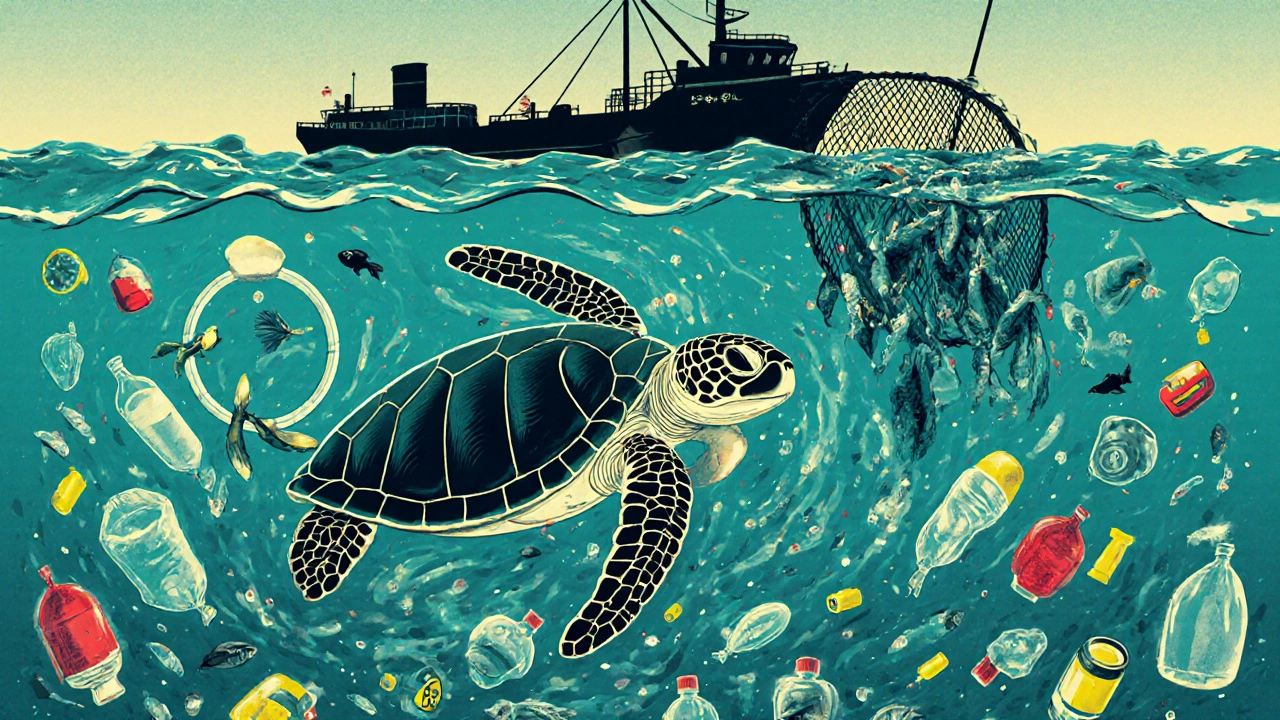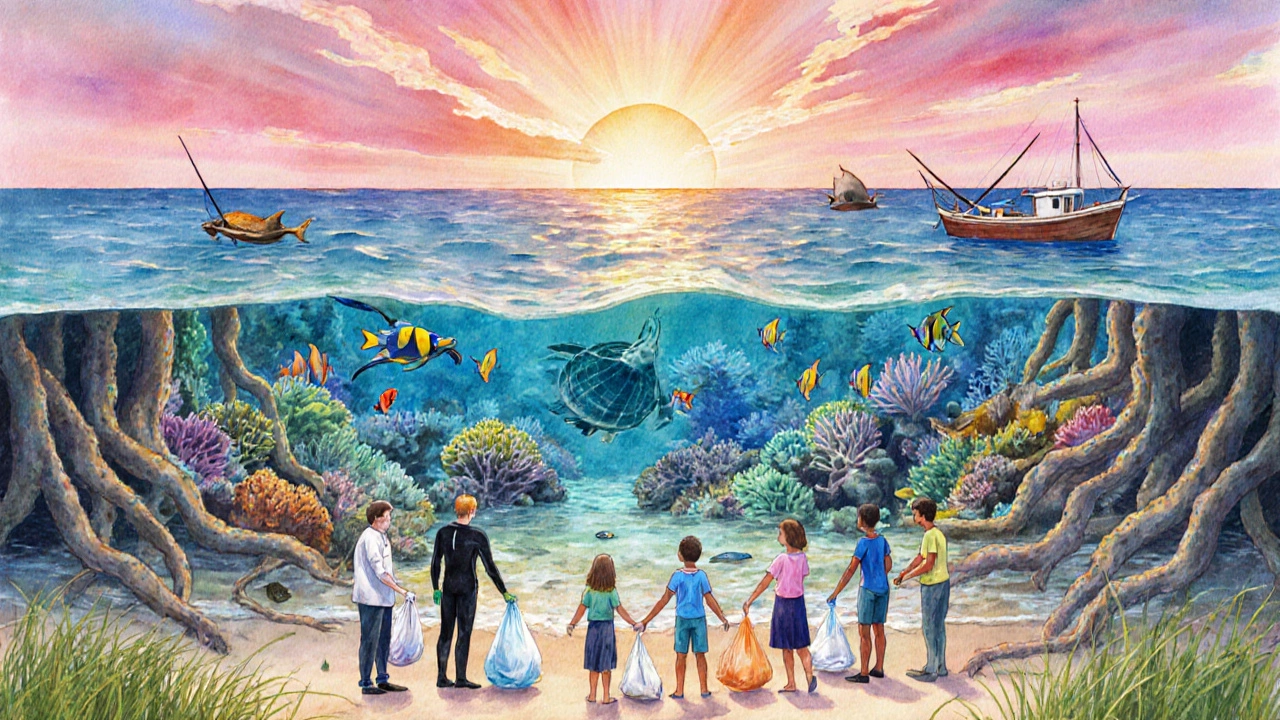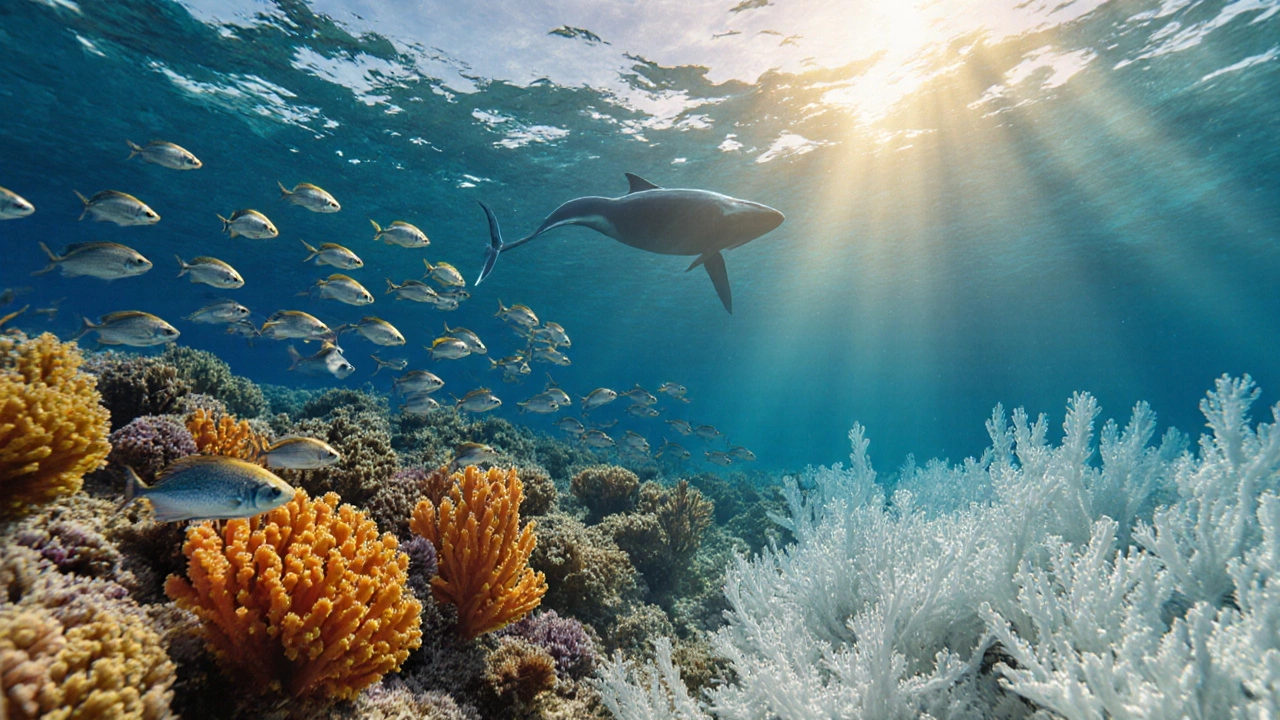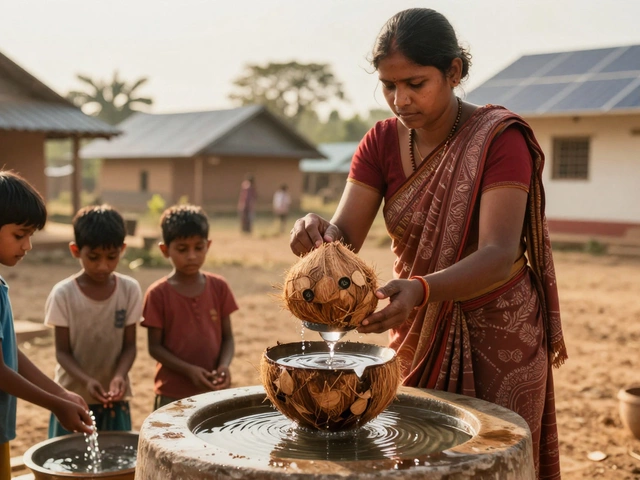Ocean Threat Impact Calculator
See how different threats to the ocean interact and compound to create greater impacts on marine ecosystems. The calculator models how these threats amplify each other based on scientific research.
Based on scientific research showing that threats interact multiplicatively rather than additively:
Climate change + Plastic pollution: +25% impact
Overfishing + Ocean acidification: +30% impact
Habitat destruction + Climate change: +20% impact
When you hear the phrase Ocean life is under attack, you might picture a whale tangled in a net or a turtle stuck in a plastic bag. The reality is far broader-and far scarier. Multiple forces are pushing marine ecosystems toward a breaking point, and understanding which one poses the biggest threat to ocean life helps us prioritize action.
Why Climate Change Is a Front‑Runner
Climate change is the long‑term shift in temperature, precipitation, and weather patterns caused primarily by human‑generated greenhouse gases. Its fingerprints are everywhere in the sea: warmer surface waters, altered currents, and more frequent extreme events. A 2024 IPCC report shows that global sea‑surface temperature has risen about 0.6 °C since pre‑industrial times, and marine heatwaves are now three times more common.
- Species migration: Fish and plankton move toward cooler latitudes, disrupting traditional food webs.
- Coral bleaching: Even a 1 °C rise can expel the symbiotic algae that give corals their color and energy, leading to mass die‑offs.
- Reproductive timing: Many marine species rely on temperature cues for spawning; a shift throws off whole generations.
These changes don’t happen in isolation. Warmer water also intensifies the impact of other threats, making climate change a multiplier rather than a lone villain.
Plastic Pollution: The Ever‑Growing Garbage Patch
Plastic pollution refers to the accumulation of synthetic polymer waste in the ocean, ranging from large debris to microscopic particles. In 2023, scientists estimated that 8 million tonnes of plastic entered the sea every year-enough to fill a football stadium every day.
Marine animals suffer in several ways:
- Ingestion: Sea turtles mistake bags for jellyfish; birds feed plastic bits to chicks, causing starvation.
- Entanglement: Nets and six‑pack rings restrict movement, leading to drowning or suffocation.
- Chemical leaching: Additives like BPA leach into water, disrupting endocrine systems of fish and mammals.
Microplastics, defined as particles smaller than 5 mm, are now found in the guts of over 90 % of surveyed marine species, including those we eat.
Overfishing: Stripping the Ocean’s Food Basket
Overfishing occurs when fish are harvested at a rate faster than they can reproduce, depleting populations and destabilizing ecosystems. The Food and Agriculture Organization reported in 2022 that 34 % of global fish stocks were overexploited.
Consequences ripple through the food chain:
- Top‑down collapse: Removing apex predators like sharks leads to an explosion of smaller species that overgraze kelp forests.
- Bycatch: Unintended catch of dolphins, sea turtles, and seabirds adds to mortality rates.
- Economic strain: Coastal communities that depend on fishing face income loss and food insecurity.
Some regions, such as the North Atlantic cod fishery, have already experienced complete collapse, taking decades to recover-if they recover at all.
Ocean Acidification: Turning the Sea Into a Weakening Soup
Ocean acidification is the process by which seawater absorbs atmospheric CO₂, lowering its pH and reducing carbonate ion availability. Since the Industrial Revolution, the average ocean pH has dropped from 8.2 to about 8.1-a seemingly small shift with massive biological consequences.
Calcium‑carbonate‑based organisms feel the pinch first:
- Shell‑forming species like pteropods and oysters struggle to build and maintain shells.
- Coral skeletons grow more slowly, weakening reef structures.
- Food‑webs falter as the base of the marine ecosystem thins.
According to a 2025 meta‑analysis, a 0.1‑unit pH drop could reduce the calcification rates of some plankton by up to 25 %.
Habitat Destruction: From Mangroves to Seagrasses
Coastal development, dredging, and bottom‑trawling smash critical habitats. Mangroves act as nurseries for many fish species, protect shorelines from storms, and sequester carbon. Yet, an estimated 35 % of global mangrove cover vanished between 2000 and 2020.
Seagrass beds, another vital carbon sink, are declining at a rate of 1-2 % per year due to anchoring, nutrient runoff, and temperature stress. Their loss not only releases stored CO₂ but also deprives juvenile fish of shelter.

Comparing the Major Threats
| Threat | Main Driver | Primary Impact on Marine Species | Top Mitigation Strategy |
|---|---|---|---|
| Climate Change | Greenhouse‑gas emissions | Range shifts, coral bleaching, altered breeding cycles | Rapid decarbonization, marine protected areas (MPAs) |
| Plastic Pollution | Single‑use plastics, inadequate waste management | Ingestion, entanglement, chemical exposure | Extended producer responsibility, cleanup initiatives |
| Overfishing | Industrial fleets, weak regulation | Stock collapse, trophic imbalance, bycatch mortality | Science‑based catch limits, community‑managed MPAs |
| Ocean Acidification | CO₂ absorption | Weakened shells, impaired calcification | CO₂ emission cuts, localized alkalinity enhancement |
| Habitat Loss | Coastal development, trawling | Nursery loss, reduced carbon sink capacity | Habitat restoration, sustainable coastal planning |
How the Threats Interact: A Vicious Cycle
The biggest danger isn’t any single factor-it's how they amplify each other. Warmer waters increase plastic degradation, creating more microplastics that cloud reefs and hinder photosynthesis. Acidic conditions make coral more vulnerable to heat‑induced bleaching, and degraded reefs can’t support fish populations, worsening overfishing pressure.
Understanding this feedback loop helps policymakers design integrated solutions rather than patchwork fixes.
What Can We Do? From Global Policies to Everyday Choices
Marine protected areas are zones where human activity is restricted to allow ecosystems to recover. Studies show that well‑managed MPAs can increase biomass by up to 3‑fold within a decade.
Key actions at different scales:
- International: Strengthen the Paris Agreement targets, support the UN's Sustainable Development Goal 14 (Life Below Water).
- National: Implement strict fishing quotas, ban single‑use plastics, fund coastal restoration.
- Community: Promote citizen science beach clean‑ups, adopt sustainable seafood guides.
- Individual: Reduce plastic use, choose certified sustainable seafood, support companies with low‑carbon footprints.
Every step counts because the ocean’s health is a shared resource. When we cut emissions, clean up waste, and give fish a chance to rebound, we protect the food we rely on and the climate regulation the sea provides.
Looking Ahead: The Next Decade
Projections from the World Bank suggest that if current trends continue, up to 50 % of coral reefs could disappear by 2050. Conversely, if global CO₂ emissions hit net‑zero by 2035 and plastic waste is cut by 70 %, many threatened species could stabilize or even recover.
The choice is stark, but the path forward is clear: cut the biggest drivers now, restore what’s lost, and build resilience for the future.

Which threat is currently the most damaging to marine life?
Climate change tops the list because it amplifies other threats like ocean acidification, heat‑stress‑induced bleaching, and species range shifts. Its global reach makes it the biggest single driver of marine ecosystem decline.
How does plastic pollution affect the food chain?
Micro‑plastics are ingested by plankton, which are then eaten by small fish, and so on up the chain. This means the plastic ends up in the bodies of larger predators-and eventually on our plates.
What are the most effective ways to reduce overfishing?
Science‑based catch limits, real‑time monitoring of fish stocks, and expanding well‑enforced marine protected areas have proven to restore fish populations quickly.
Can ocean acidification be reversed?
Direct reversal is difficult, but reducing CO₂ emissions will gradually lower acidity. Local interventions like adding alkalinity‑rich minerals can help vulnerable reefs in the short term.
What role do mangroves play in protecting marine life?
Mangroves serve as breeding grounds for fish, buffer coastlines against storms, and lock away carbon. Their loss reduces fish nursery space and weakens coastal defenses.





